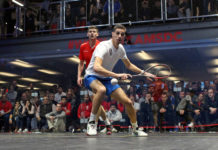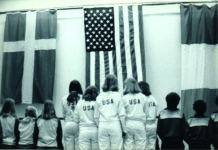By Kevin Klipstein
U.S. Squash recently announced that the prize purse for the 2013 Delaware Investments U.S. Open will provide equal prize money for both the men’s and women’s championships. The purse will be the largest in U.S. Open history and one of the largest in squash worldwide. This will be the first men’s and women’s World Series level event to offer parity.
Last year was the 30th Anniversary of Title IX, the constitutional law that prohibits discrimination based on gender in athletics and academics. Massive, yet still controversial progress has been made in equalizing opportunities in athletics for girls and young women. More opportunities to compete in college have driven incredible growth in the number of girls participating in sports at a younger age. However, according to many female sports figures, and certainly many WSA players, the fight for equality is far from over. The U.S. Open in tennis led the way by offering parity in prize money more than 30 years ago, yet this continues to be a widely debated move and some other Grand Slams have only recently followed.
Given how far equal rights and opportunities have come in the US, not only in the most basic differences between genders and races, but also in disability, sexual orientation, and national origin, from a certain perspective, it is surprising this is still an issue at all. The fact that it is, makes actions such as offering equal prize money, which is both fair compensation, and a social cue as to what is acceptable, all the more important and relevant.
This may explain this reaction of sports icon and social justice pioneer Billie Jean King to our announcement, “Any time you can achieve equality in any field of endeavor—be it in sports or in life—everyone wins. This announcement is so much more about the message than the money and I am thrilled another U.S. championship event has stepped up and done the right thing.”
To this day real disparities in rights and opportunities for women and girls continue in the US, and even more so internationally. For recent unequivocal evidence, look no further than Maria Toor Pakay, the Pakistani squash player who, fearing the Taliban and the consequences of continuing to play and train, was forced to flee her country and move to Canada, where she is now flourishing under the tutelage of Jonathan Power. In a 21st century world with few boundaries, the messages we send, large and small, overt and subtle, matter.
Meeting recently with international leaders of women’s squash, we discussed two central components to presenting squash as both competition and entertainment. First is that people are more interested in a close contest between competitors, regardless of gender, and second, the more you know the people, the more interesting the competition becomes.
I was on a plane several years ago, watching an in-flight program about a regional high school track and field event. Although it was documenting a fairly average athlete’s personal struggles, I was gripped. The people’s stories were interesting, their struggles real, and the competition close. As the program culminated in the final race to determine who would move on to the next level, my heart raced with anticipation and anxiety. I was totally spellbound…about a person I didn’t know, from a place I had never visited, and by a sport I’ve never watched.
Some will argue, though they will do so in the shadows, that women on the tour should earn the same as men only when the playing level of their matches equals that of the men. Others will highlight the appearance that the women’s tour currently has less depth than the men’s tour worldwide. Both of these arguments completely miss the point of offering equal prize money. As King points out, it’s about the message it sends, it’s the right thing to do, and lastly, it’s about opportunity.
As the profile and exposure for squash continues to increase, and our ability to tell stories about the players improves, these factors, combined with increased opportunities for girls and women around the world to play, will allow even more female squash players to compete at the highest level and to their full potential. Whether it’s two women playing, two men, or the increasingly possible match pitting a woman versus a man, what I am really looking for is a close match, and I have no doubt I’ll get my money’s worth.





